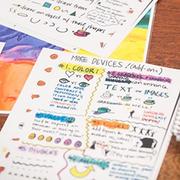
You attend a meeting or a class. You need to remember the content for your next project discussion, presentation, or future assignment. Chances are you do what you always do. For many of us this means taking notes—with words—sometimes lots of words. But have you examined your note-taking habits? Are there more effective ways you can retain—and even communicate—information to those who weren’t present? Have you ever tried thinking graphically?
This was the challenge for three Harvard T.H. Chan School of Public Health students in the Master of Science program in Global Health & Population who attended an Incubator pilot workshop, “Introduction to Visual Literacy,” in early May. Co-facilitated by Incubator Director, Dr. Sue J. Goldie, and one of their cohort peers, Nina Bhattacharya, an Incubator student fellow, the workshop focused on how visual communication can be used in the area of health. “The topic interested my classmates,” Nina recalled, explaining her motivation to develop the workshop, “and I also wanted to have peers who had experienced these tools first hand. This way we can reflect on their uses in the health field together.”
Professor Goldie began by asking, “How do you take notes in the classroom?” Students’ responses ranged from “very word heavy” to “no notes during class, but post-class reflections often in the form of pictures.”
“Today we want you to experience taking notes using pictures,” Goldie challenged them.
For the rest of the workshop, the group explored how to represent ideas and concepts graphically. They began by trying to explain migration through illustration, pausing to discuss their individual strategies for representation afterward. Professor Goldie and Nina then showed an Incubator produced video that explore the topic of migration through pictures. Next, they shared a basic toolkit of visual literacy techniques. Nina showed how one could quickly and easily represent a range of emotions using only a circle, dots, and lines. Finally, the students applied their new skills by taking graphical notes on the TED talk, “Menstrupedia;” the comic book helps break down menstruation taboos in a format that gives girls, women, and even boys access to critical health information about the female body. Reflecting on their efforts, Goldie remarked, “It was interesting to watch all the drawing and writing going on, which is great, but try to do more watching and listening.”
Participants spent the last few minutes sharing reflections and questions. Thinking graphically rather than just in words made them think about their ideas differently, they said. Even so, they were relieved to learn that using visual communication did not mean excluding words, but rather shifting how they thought about words—to use them more judiciously on the page, carefully consider their placement, and reorient their relationship to words “as images that are just in the shape of language and letters.”
How might these skills be applied in workplace settings, they wondered, particularly with policymakers? One participant worried that her colleagues might not take her ideas very seriously if she shared colorful drawings. “Visual communication, like any other communication,” said Goldie, “needs to be considered in context.” She reminded the participants that a drawing’s tone can be altered to be more serious or lighter depending on the situation. She urged to students, however, “to remember the power of the visual!” She gave the examples of how she had used images and drawing to explain unfamiliar topics to non-subject experts so they could participate in meetings, and how, in another setting, she and a colleague used images with an audience of policymakers to highlight the impact of certain interventions.
Developing visual literacy skills takes practice, she reminded the group. Their homework was to watch Bill Gates’ TED Talk, “The Next Outbreak? We’re Not Ready” and take graphical notes; a few days later, to read and take notes directly on the transcript; and a day or so after that, to compare and contrast the two experiences, noting how their experiences differed even using the same content. “Come back and tell us what you notice,” said Goldie. “The Incubator looks forward to learning from you!”
Visit the “Studios” section of our website to find out more about the Incubator’s approach to drawing and graphics.
